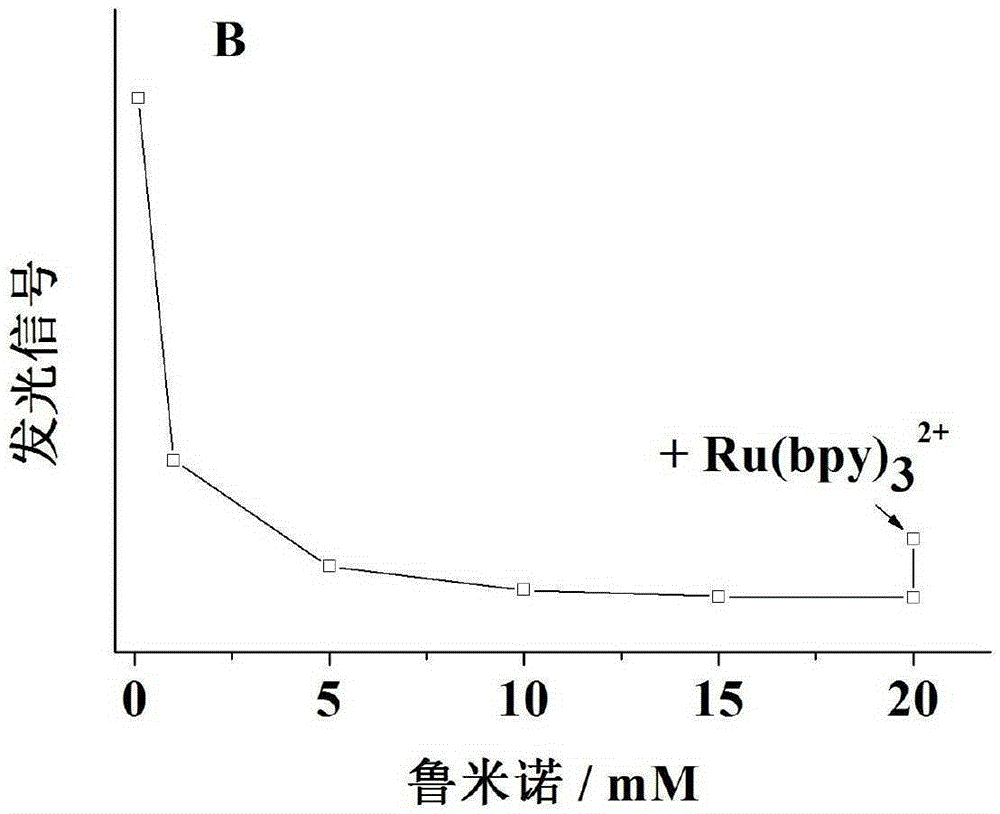A potential-resolved electrochemiluminescence detection method based on luminol and bipyridylruthenium and its application
A bipyridyl ruthenium and luminescence detection technology, which is applied in the field of biomedicine, can solve problems such as difficulty in luminescence, and achieve the effect of eliminating mutual interference
- Summary
- Abstract
- Description
- Claims
- Application Information
AI Technical Summary
Problems solved by technology
Method used
Image
Examples
Embodiment 1
[0040] Example 1 Potential-resolved electrochemiluminescence of luminol and bipyridylruthenium in solution.
[0041] (1) Cross-reaction of ruthenium bipyridyl and luminol in solution at negative potential.
[0042] Detection conditions: when there are 3mM persulfate particles in the system, the luminescence curves of 100 μM bipyridyl ruthenium, a mixed solution of 100 μM bipyridyl ruthenium particles and 100 μM luminol, and 100 μM luminol are respectively detected under negative potential conditions. Among them, the whole detection system is in the PBS buffer solution of pH 7.4, an O-ring is attached to the surface of the ITO electrode as the solution chamber, the ITO electrode is used as the working electrode for luminescence detection, and the silver-silver chloride electrode is used as the reference electrode. The platinum electrode was used as the counter electrode, and the voltage sweep rate was -0.2V / s (the voltage sweep rate in the following embodiments all used -0.2V / s...
Embodiment 2
[0056] Example 2 Potential-resolved electrochemiluminescence of luminol and ruthenium bipyridyl on particle surface.
[0057] In order to simulate the simultaneous detection of two antigens on the cell surface using luminol and ruthenium bipyridyl potential-resolved electrochemiluminescence, we modified the antigen on a silica surface with a diameter of about 20 μm, which is similar to the cell size. In the analytical experiments, the particles settled on the electrode surface, simulating the adhesion behavior of cells. Specifically, include the following steps:
[0058] (1) Preparation of antibody-modified luminol complex: the preparation process is as follows Figure 5 (1) shown. Set the concentration to 10 -3 M's 3-mercaptopropionic acid (3-MPA) was first added to a solution of gold nanoparticles (AuNPs) with an average diameter of 13 nm. The mixed solution was reacted at 37°C for 12 hours, and then centrifuged at 14,000 rpm for 30 minutes to collect gold nanoparticle c...
Embodiment 3
[0071] Example 3 Combined detection of two antigens on the cell surface.
[0072] MCF-7 cells and PC-3 cells were cultured in DMEM high glucose medium and F- Cultured in 12K medium. Cells were cultured in 5% (v / v) CO 2 , in a cell culture incubator with a temperature of 37 °C and a humid atmosphere. Wherein, the antibiotic is a mixture of penicillin and streptomycin, wherein the concentration of penicillin is 100 U / ml, and the concentration of streptomycin is 100 μg / ml. That is, the total volume of the culture medium is 500ml, wherein the fetal bovine serum is 50ml, and the mixed solution of penicillin and streptomycin purchased as 10000U / ml and 10000μg / ml (purchased from ThermoScientific penicillin-streptomycin 100X solution (HyClone TM Penicillin-Streptomycin100XSolution), add 5ml into 500ml, which is equivalent to diluting 100 times to reach the concentration of penicillin 100U / ml and streptomycin 100μg / ml.
[0073] Such as Figure 10 As shown, the same process as abov...
PUM
| Property | Measurement | Unit |
|---|---|---|
| diameter | aaaaa | aaaaa |
| particle diameter | aaaaa | aaaaa |
| concentration | aaaaa | aaaaa |
Abstract
Description
Claims
Application Information
 Login to View More
Login to View More - R&D
- Intellectual Property
- Life Sciences
- Materials
- Tech Scout
- Unparalleled Data Quality
- Higher Quality Content
- 60% Fewer Hallucinations
Browse by: Latest US Patents, China's latest patents, Technical Efficacy Thesaurus, Application Domain, Technology Topic, Popular Technical Reports.
© 2025 PatSnap. All rights reserved.Legal|Privacy policy|Modern Slavery Act Transparency Statement|Sitemap|About US| Contact US: help@patsnap.com



